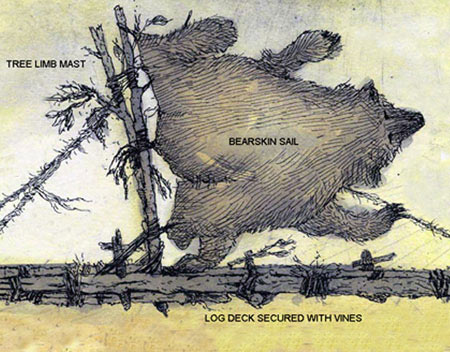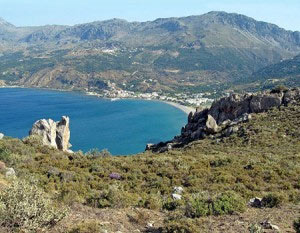Skip to comments.
The Discovery that Revealed Ancient Humans Navigated the Seas 130,000 Years Ago [2013]
Ancient Origins ^
| 25 October 2013
| John Black
Posted on 07/15/2016 10:47:46 AM PDT by Fractal Trader
It was a few years ago that a Greek-American archaeological team made a startling discovery – they found the oldest indications of seafaring and navigation in the world, in an area called Plakia on Crete Island in Greece. It is an incredibly important discovery that is given little attention, despite the fact that it reached the top ten discoveries of 2010. Their research is forcing scholars to rethink the maritime capabilities of early human and pre-human cultures.
The team of archaeologists were carrying out excavations in a gorge on the island of Crete when they discovered a Palaeolithic site in the canyon of Preveli, where more than 30 hand axes and hundreds of other stone tools, such as cleavers and scrapers, made from quartz were found scattered across more than 20 different locations. Until this discovery, it was believed that ancient humans reached Crete, Cyprus, a few other Greek islands, and possibly Sardinia, no earlier than 12,000 years ago. However, remarkably, the stone tools found at Parkia were dated to at least 130,000 years old.
The tools were dated through stratigraphic analysis, a branch of geology which studies rock layers. The cliffs and caves above the shore were uplifted in the ancient past by tectonic forces. The exposed uplifted layers represent the sequence of geologic periods that have been well studied and dated. The team analyzed the layer bearing the tools and determined that the soil had been on the surface 130,000 to 190,000 years ago.
Rocky bluffs around the village of Plakia were actually the shoreline zone in prehistoric times. This is where the team began excavations. Image source . Considering Crete has been an island for five million years, the tools could have only arrived in that location if ancient humans or pre-human species travelled there by boat.
(Excerpt) Read more at ancient-origins.net ...
TOPICS: Chit/Chat; History; Weird Stuff
KEYWORDS: ancientnavigation; crete; godsgravesglyphs; greece; navigation; neandertal; neandertals; neanderthal; neanderthals; palaeolithic; plakia
Navigation: use the links below to view more comments.
first previous 1-20, 21-40, 41-50 next last
To: Fractal Trader
Archaeologist think nothing ever happened before they themselves were born.
21
posted on
07/15/2016 1:28:46 PM PDT
by
bgill
(From the CDC site, "We don't know how people are infected with Ebola")
To: Fractal Trader; SunkenCiv
Maybe they didn’t cruise there. Maybe they just crawled onto the land from the sea and evolved there independently.
I have a problem with bearskin sails from Africa.
22
posted on
07/15/2016 1:48:25 PM PDT
by
wildbill
(If you check behind the shower curtain for a slasher, and find one.... what's your plan?)
To: SunkenCiv
Still waiting for your take on this.....
To: StayAt HomeMother; Ernest_at_the_Beach; 1ofmanyfree; 21twelve; 24Karet; 2ndDivisionVet; 31R1O; ...
Note: this topic is from . Thanks Fractal Trader.

24
posted on
04/11/2020 11:44:31 PM PDT
by
SunkenCiv
(Imagine an imaginary menagerie manager imagining managing an imaginary menagerie.)
To: butlerweave
“The Morons today think Ancient Humans were Morons”
There’s more flat earthers running amok now than there were then. ‘Idiocracy’ turned out to be a documentary.
25
posted on
04/11/2020 11:50:34 PM PDT
by
Pelham
(Mary McCord, Sally Yates and Michael Atkinson all belong in prison.)
To: butlerweave
“The Morons today think Ancient Humans were Morons”
There’s more flat earthers running amok now than there were then. ‘Idiocracy’ turned out to be a documentary.
26
posted on
04/11/2020 11:50:35 PM PDT
by
Pelham
(Mary McCord, Sally Yates and Michael Atkinson all belong in prison.)
To: Fractal Trader
27
posted on
04/12/2020 12:28:03 AM PDT
by
ASOC
(Having humility really means one is rarely humiliated)
To: Fractal Trader
I would really like this to be true, because I am a firm believer than man was indeed seafaring long before we think they were. But being objective and knowing some geology about Quartz, the artifacts do not appear to be manmade. Quartz tends to naturally fracture off of dikes and veins with those shapes as very common because of it’s crystalline structure.
And the weathering appears to be much much more than a very young 130k in geology standards. I could go out and collect a hundred from a local vein that look just like that. So unfortunately this whole find revolves around whether those are geofacts or not and I lean heavily towards geofacts.
28
posted on
04/12/2020 10:52:19 AM PDT
by
Openurmind
(The ultimate test of a moral society is the kind of world it leaves to its children. ~ D. Bonhoeffer)
To: Fractal Trader
***
Considering Crete has been an island for five million years, the tools could have only arrived in that location if ancient humans or pre-human species travelled there by boat***


29
posted on
04/12/2020 11:37:42 AM PDT
by
Bob Ireland
(The Democrap Party is the enemy of freedom.They use all the seductions and deceits of the Bolshevics)
To: SunkenCiv
Thanks for the ping on this!
30
posted on
04/12/2020 11:41:55 AM PDT
by
Bob Ireland
(The Democrap Party is the enemy of freedom.They use all the seductions and deceits of the Bolshevics)
To: Fractal Trader; SunkenCiv
***
 Rocky bluffs around the village of Plakia were actually the shoreline zone in prehistoric times
Rocky bluffs around the village of Plakia were actually the shoreline zone in prehistoric times***
A 'prehistoric shoreline' found high upon a bluff would seem to me to indicate that it must have been so prior to the last ice age since later the sea levels were supposedly much lower than today. {Confirms earlier chronology}
31
posted on
04/12/2020 12:47:30 PM PDT
by
Bob Ireland
(The Democrap Party is the enemy of freedom.They use all the seductions and deceits of the Bolshevics)
To: SunkenCiv
32
posted on
04/12/2020 1:32:20 PM PDT
by
Bob Ireland
(The Democrap Party is the enemy of freedom.They use all the seductions and deceits of the Bolshevics)
To: Bob Ireland
My pleasure. This was originally posted during my FR quarantine, and I'd not seen it 'til now. Be sure to visit the similar and related topics from the FRchives.
33
posted on
04/12/2020 3:11:00 PM PDT
by
SunkenCiv
(Imagine an imaginary menagerie manager imagining managing an imaginary menagerie.)
To: Pelham; Fractal Trader; ASOC; Openurmind; Bob Ireland
34
posted on
04/12/2020 3:22:00 PM PDT
by
SunkenCiv
(Imagine an imaginary menagerie manager imagining managing an imaginary menagerie.)
To: Bob Ireland
35
posted on
04/12/2020 4:06:23 PM PDT
by
SunkenCiv
(Imagine an imaginary menagerie manager imagining managing an imaginary menagerie.)
To: SunkenCiv
You were nearly 4 years late on this one.
36
posted on
04/12/2020 4:30:59 PM PDT
by
Sawdring
To: Sawdring
Yeah, I wasn't available on FR for an entire year, I guess you didn't miss me... [breaks quarantine rules by wiping eyes]
37
posted on
04/12/2020 5:21:35 PM PDT
by
SunkenCiv
(Imagine an imaginary menagerie manager imagining managing an imaginary menagerie.)
38
posted on
04/12/2020 7:23:44 PM PDT
by
Bob Ireland
(The Democrap Party is the enemy of freedom.They use all the seductions and deceits of the Bolshevics)
To: SunkenCiv
Population crossed at much earlier date, when Med was lower than today, perhaps short haul, line of sight, island hopping.
The future population had enough sense to move their community to higher ground as water rose to points higher than today, rather than drown.
The higher water reduced total area of island, reducing carrying capacity; climate would also be affected, maybe adversely affecting traditional food sources, so population became to low to sustain itself, and died out?Fresh water sources became scarcer?
Rising water & sedimentation joined in wiping out any trace of earlier, (and probably still submerged) lower sites?
Maybe “artifacts” are misinterpreted?
39
posted on
04/13/2020 10:59:43 AM PDT
by
ApplegateRanch
(Love me, love my guns!)
To: ApplegateRanch
Humans have navigated open water for at least 800K years. No one walked to Crete, ever.
40
posted on
04/13/2020 12:19:44 PM PDT
by
SunkenCiv
(Imagine an imaginary menagerie manager imagining managing an imaginary menagerie.)
Navigation: use the links below to view more comments.
first previous 1-20, 21-40, 41-50 next last
Disclaimer:
Opinions posted on Free Republic are those of the individual
posters and do not necessarily represent the opinion of Free Republic or its
management. All materials posted herein are protected by copyright law and the
exemption for fair use of copyrighted works.
FreeRepublic.com is powered by software copyright 2000-2008 John Robinson



